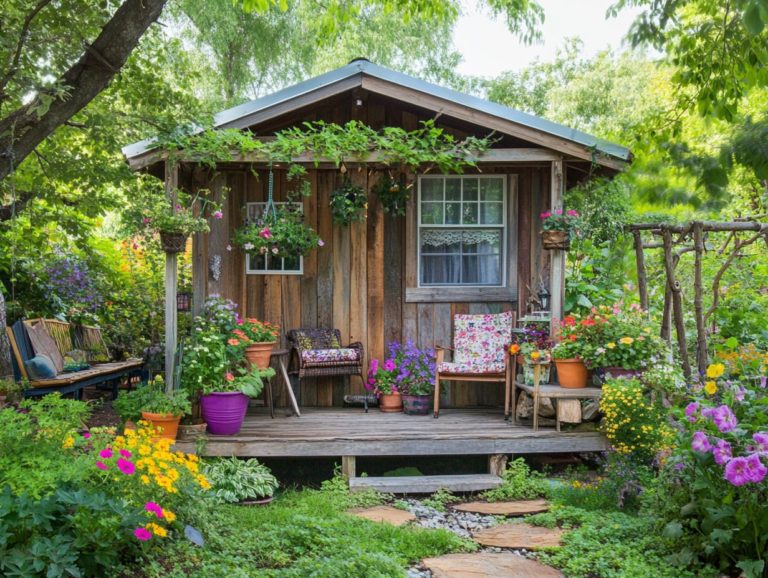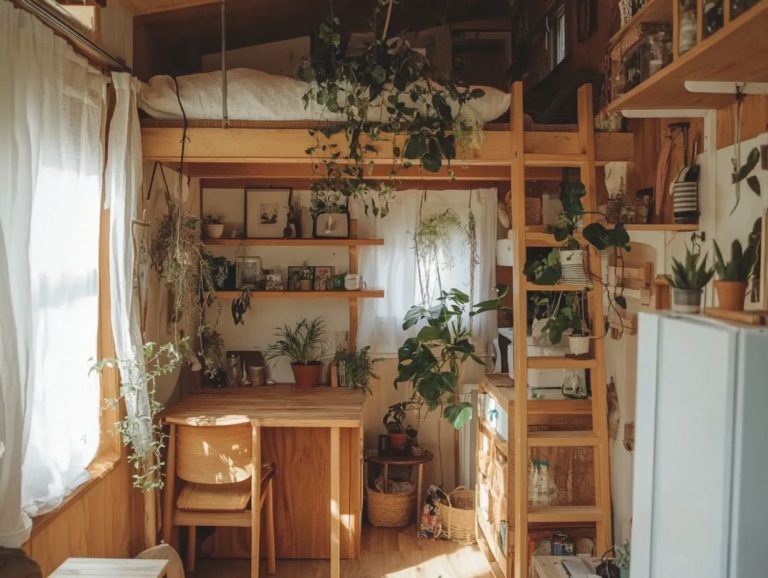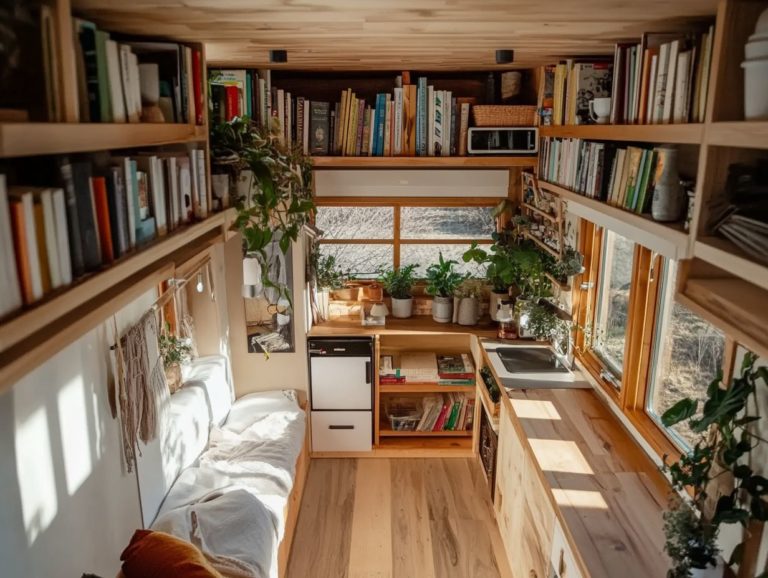Creating a Tiny House Outdoor Shower: DIY Guide
Looking to elevate your tiny house experience? An outdoor shower could be just the luxurious upgrade you need.
Not only does it offer a refreshing retreat, but it also makes the most of your limited space. This guide will take you through the entire process from choosing the perfect location and gathering essential materials to detailed building instructions and plumbing setup.
You ll also discover creative finishing touches that will ensure your shower is both functional and stylish.
Let s jump right in and get started on your dream outdoor shower!
Contents [hide]
- Key Takeaways:
- Choosing the Right Location
- Materials and Tools Needed
- Building the Shower Structure
- Plumbing and Water Supply
- Adding Finishing Touches
- Frequently Asked Questions
- What materials do I need to create a tiny house outdoor shower, and how can I incorporate cedar or PVC?
- Do I need a permit to build a tiny house outdoor shower or for a DIY outdoor shower project?
- How much does it cost to build a tiny house outdoor shower, and can I do it as a summer DIY project?
- Can I use a solar shower in my tiny house outdoor shower, or should I consider an outdoor shower enclosure?
- Do I need to have plumbing experience to build a tiny house outdoor shower?
- How do I maintain and clean a tiny house outdoor shower, ensuring proper drainage and water supply lines?
Key Takeaways:
- Save space and add a unique touch to your tiny house by opting for an outdoor shower.
- Consider factors like privacy, sunlight exposure, and convenience when choosing the perfect location for your outdoor shower.
- Gather essential supplies and follow step-by-step instructions to build a sturdy and functional outdoor shower for your tiny house.
Why Choose an Outdoor Shower for a Tiny House?
Choosing an outdoor shower for your tiny house goes beyond mere functionality; it s about crafting a serene retreat that elevates your outdoor experience. Picture yourself basking in the comforting warmth of water on a hot summer day, enveloped by nature’s beauty.
An outdoor shower can transform your compact living space into a tranquil oasis, offering a chic and comfortable way to refresh after a long day or a sandy beach adventure all while catering to your unique design and functional preferences.
By effortlessly blending into the natural surroundings, this feature invites a deeper connection with the environment. Routine moments become refreshing experiences, and many homeowners find that showering outdoors turns daily rituals into delightful escapes.
With options ranging from rustic wooden fixtures to sleek, modern designs, you have the freedom to customize your outdoor sanctuary, ensuring it reflects your personal style and feels inviting.
Nature’s soothing sounds will be the perfect backdrop for your relaxation and mindfulness, ultimately redefining what it means to savor life in a tiny house.
Choosing the Right Location
Finding the right spot for your outdoor shower is key to making it practical and attractive. You want it to enhance your backyard while ensuring privacy and easy access.
Consider spots that offer natural screening perhaps a fence or a privacy wall while also being near water sources like the outdoor faucet and drainage area. This way, you ll pave the way for a seamless installation that elevates your outdoor experience.
Factors to Consider
When you’re planning to install an outdoor shower, there are several key factors to consider: location, budget, and your personal design and functionality preferences. You ll want to choose a spot that offers comfortable access, while your budget will shape the materials and features you can incorporate into your outdoor oasis.
Your personal preferences will significantly influence the type of outdoor shower you select, whether you lean towards a simple, minimalist design or a more elaborate setup that includes privacy screens and multiple water settings. If you’re also considering outdoor features, check out this guide on how to build a DIY tiny house porch.
The installation process is another crucial aspect. If you decide to take the DIY route, you’ll need to keep local plumbing codes and terrain conditions in mind. On the other hand, hiring a professional can ensure a smooth execution, although it might come with a higher price tag.
These factors will dictate the ease of installation and elevate your overall outdoor shower experience, ensuring it fulfills both your functional needs and aesthetic desires.
Materials and Tools Needed
Gathering the right materials and tools is crucial for your DIY outdoor shower project, ensuring both durability and aesthetic appeal. Consider using cedar for its natural resistance to the elements, along with PVC for plumbing connections.
Don t forget to add decorative elements like vibrant tiles or smooth stones for the shower enclosure, as they enhance both functionality and style, transforming your outdoor space into a personal oasis.
Essential Supplies for Building an Outdoor Shower
To create a functional outdoor shower, you’ll need some essential supplies: a shower control unit, a garden hose connection, and drainage gravel. These components are crucial for crafting an outdoor shower experience that seamlessly integrates into your daily routine.
The shower control unit is your main control center, allowing you to adjust the water temperature and flow. This ensures you enjoy a refreshing wash, no matter the weather.
A reliable garden hose connection is equally important, as it facilitates the smooth transfer of water from your home s supply, making setup easy without requiring extensive plumbing changes.
Incorporating drainage gravel is a smart choice. It promotes good drainage and prevents pooling around the shower area, creating a more sanitary environment. Each of these supplies plays a vital role in optimizing the overall performance and longevity of your outdoor shower, enhancing your time spent in nature.
Building the Shower Structure
Building the structure of your outdoor shower requires meticulous planning and a steadfast vision. You want it to endure the elements while enhancing the beauty of your backyard.
Begin by sketching your design, thoughtfully considering dimensions, height, and its positioning in relation to other outdoor features.
Step-by-Step Instructions
Get ready to dive into the fun of installing your outdoor shower! It s an adventure that enhances your outdoor experience. Follow this well-organized series of steps for a successful and efficient setup, including connecting the hot water line and garden hose for a steady water supply.
- Begin by choosing the perfect location that balances privacy and accessibility. Once you’ve marked the layout, dig a trench for the water lines, ensuring it’s deep enough to fend off frost and the elements.
- Next, lay down the plumbing, connecting the hot water line with all the necessary fittings, and securely attach the garden hose outlet for added convenience.
- As you move forward, think about incorporating a sturdy support structure to hold the showerhead. Then, tackle the drainage installation to effectively manage runoff.
- Finally, sprinkle on some finishing touches, like water-friendly landscaping around the area, to transform your outdoor oasis into a functional and visually stunning retreat.
Plumbing and Water Supply
Knowing the plumbing and water supply needs ensures your outdoor shower works perfectly. Whether you opt for a dedicated hot water line or an outdoor faucet linked to your home s plumbing, proper installation of the water supply lines will ensure seamless functionality during your daily shower routine.
This attention to detail transforms your outdoor bathing into a luxurious escape rather than just a necessity.
Connecting to Existing Water Systems
Connecting your outdoor shower to existing water systems is a savvy choice that streamlines the installation process. This method not only saves you valuable time but also minimizes costs related to plumbing modifications.
By tapping into your current water supply, you can conveniently access fresh water for rinsing off after gardening or swimming. It’s essential to consider factors such as the optimal placement of the outdoor shower and the appropriate type of hose connectors to ensure a steady water supply.
Adding a mixing valve a device that allows you to mix hot and cold water can also offer adjustable temperature control, elevating your showering experience.
Check local plumbing codes to avoid legal issues during installation, guaranteeing that your outdoor shower integrates seamlessly into your home s water system.
Adding Finishing Touches
Adding those final touches to your outdoor shower can truly elevate the experience, turning a straightforward installation into a stunning freestanding outdoor spa.
Consider thoughtful accessories like a stylish shower caddy for your essentials, decorative tiles to add character, and natural elements that blend seamlessly with the surroundings.
These enhancements boost functionality and enrich the visual appeal, transforming your backyard into a personal paradise!
Start building your outdoor shower today and enjoy your new space!
Decor and Accessories for a Functional and Stylish Shower
Adding decorations and accessories to your outdoor shower design is essential for crafting a space that is both functional and stylish. This elevates your entire outdoor shower experience.
To achieve this, think about adding decorative shelving to hold your shampoos and soaps. It keeps essentials close and looks great too! Integrating plants is another fantastic idea they provide privacy while infusing your space with life and color. This creates a tranquil atmosphere.
Consider textiles like outdoor rugs, which offer comfort underfoot and introduce a vibrant splash of color and texture. Don’t overlook how lighting can enhance your space. Subtle string lights or lanterns can transform the ambiance, making evening showers a truly enjoyable experience.
When combined, these elements enhance not just the functionality but also the aesthetic appeal of your outdoor shower, turning it into a delightful retreat.
Frequently Asked Questions
What materials do I need to create a tiny house outdoor shower, and how can I incorporate cedar or PVC?
To create a tiny house outdoor shower, you will need a shower head, plumbing pipes, a shower curtain, a shower pan (the base that collects water), and waterproofing materials. You may also want to add decorative elements such as tiles or stones.
Do I need a permit to build a tiny house outdoor shower or for a DIY outdoor shower project?
The need for a permit to build a tiny house outdoor shower varies depending on your location. It is best to check with your local government or building department to see if a permit is required.
How much does it cost to build a tiny house outdoor shower, and can I do it as a summer DIY project?
The cost of building a tiny house outdoor shower can vary greatly depending on the materials and size. On average, it can cost anywhere from $500 to $2,000. DIY options tend to be more cost-effective than hiring a professional.
Can I use a solar shower in my tiny house outdoor shower, or should I consider an outdoor shower enclosure?
Yes, you can use a solar shower in your tiny house outdoor shower. These portable showers use solar energy to heat water, making them a great environmentally-friendly option for tiny house living.
Do I need to have plumbing experience to build a tiny house outdoor shower?
Some plumbing experience is helpful, but extensive knowledge isn’t necessary. Many step-by-step guides and tutorials are available online to help you through the process.
How do I maintain and clean a tiny house outdoor shower, ensuring proper drainage and water supply lines?
To maintain and clean your tiny house outdoor shower, regularly check for leaks or damage and make repairs as needed. Clean the shower walls and floor with a mild soap and water solution, and periodically disinfect with a diluted bleach solution. Also, replace the shower curtain or liner when necessary to prevent mold and mildew buildup.
Ready to create your own outdoor shower? Start planning your project today!



